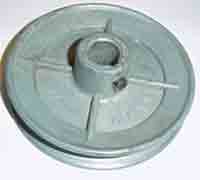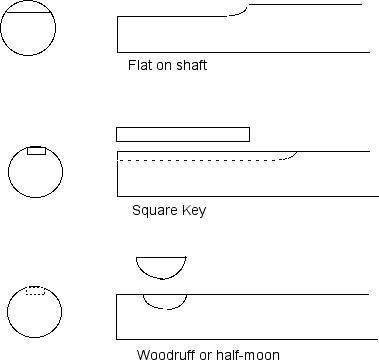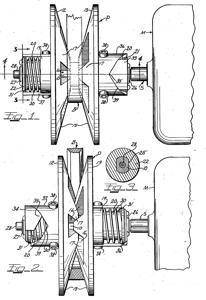| When
building or modifying machinery it is necessary to calculate the size
of gears or pulleys required to run a tool at a certain speed. Sometimes
it is relatively simple, if you are replacing a 3450 RPM motor with a
1725 RPM one usually all you have to do is double the size of the pulley
on the motor to run the machine at the same speed.
Going
the other way, replacing a 1725 RPM motor with a 3450 RPM motor may not
be so simple if the driving pulley on the motor is already a small
diameter. The required pulley would be too small to be practical so the
driven pulley would have to be replaced, however if this pulley is
already fairly large, doubling the size of it would again be
impractical. To get around this the pulley on the motor will have to be
somewhat smaller and the pulley on the machine will have to be somewhat
larger, this can be calculated using a formula.
Gear Speeds & Sizes
Speed of Driven Gear = Teeth on driving gear multiplied by RPM of driving gear divided by teeth on driven gear.
Teeth of Driven Or Driving Gear = Teeth on gear multiplied by its RPM divided by RPM required.
Speed of Last Driven Gear
Divide
product of driving gear sizes (number of teeth) by product of driven
gear sizes and multiply quotient by RPM of first driving gear, this
equals speed of last driven gear.

Ratios of Gear Drives
A
gear ratio indicates the speed relationship between driving and driven
gears. For example if a driving gear has 15 teeth and the driven gear
has 45 teeth the ratio is 45 divided by 15 which equals 3 giving a ratio
of 3 to 1.
Pulley Speeds and Sizes
Size of Driven or Driving Pulley = Diameter of pulley multiplied by its RPM divided by RPM required.
Speed of Last Driven Pulley
Divide
product of driving pulley diameters by product of driven pulley
diameters and multiply quotient br RPM of first driving pulley, this
equals speed of last driven pulley.
| Power Twist Link Belt | | Turn
your tools into smooth operators!
Reduce vibration on table saws, drill presses, and other tools by as
much as 35% with this unique belt. Whereas traditional belts can stretch
and become misshapen (creating vibration as they rotate), the Power
Twist Link Belt is
made up of interlocking segments of polyurethane elastomer and
multiple plies of polyester fabric that retain their original shape,
thereby reducing vibration.
What's more, you can easily add or subtract links to get optimal
tension on most machines! Power Twist Link Belt |  |
 |
Problems
such as whipping and twisting with multiple belt driven applications
may be alleviated using a single bonded style belt. |

Use 1018 cold rolled steel for shafts.
Fastening Pulleys
 |
Pulleys
are generally fastened to a shaft by means of a set screw in the hub,
this set screw may tighten against a flat spot on the shaft or against a
key. |

Pulleys may also be fastened to the shaft by means of a split hub.
This
is a two part pulley consisting of the split hub and the sheave. The
outer surface of the hub and the bore of the sheave are tapered, as the
two bolts are tightened the hub is forced into the sheave causing it to
tighten on the shaft. To remove the pulley the bolts in the hub are
loosened and bolts are tightened into the other pair of threaded holes
forcing the hub out of the sheave,
Variable Speeds
There
are applications where it is necessary to have a range of speeds for
different operations, one method is to use two or more step pulleys,
such as commonly used on lathes and drill presses.

Rather
than having a fixed range of speeds sometimes it is desirable to have
an infinate range of speeds, this is accomplished by using movable
sheaves on a pulley. As tension is put on the belt, by moving the drive
farther out, the sheaves are forced apart reducing the diameter of the
driving pulley.

|

